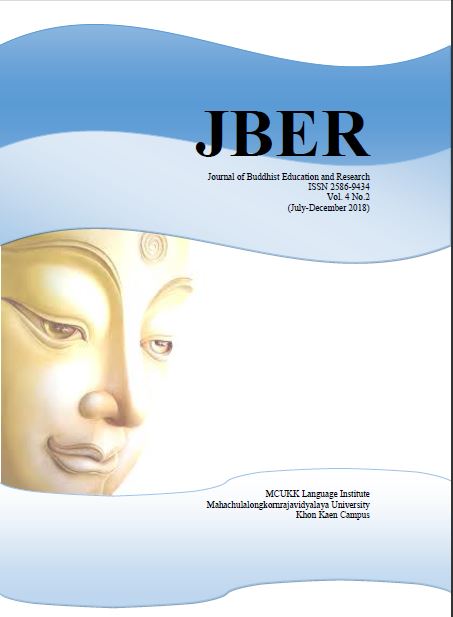SMILE OF PEACE: JAYAVARMAN VII’S CONFLICT RESOLUTION TOWARD PEACE AND DEVELOPMENT IN ANGKOR ERA
คำสำคัญ:
Jayavarman VII, Smile of Peace, Angkor Era, Conflict, Peace, Resolutionsบทคัดย่อ
This academic paper is conducted to explore how Khmer great kings in the past used Buddhism as a way to conflict resolution. The paper suggests that Buddhism became the dominance religion in Cambodian after the King Jayavarman VII got the crown. Before that Khmer Empire was dominated by Hinduism and one can see the explanation through the ruined temples such as Angkor Wat temple. Throughout the discussion, the paper found that King Jayavarman VII was inspired by his second queen to support and promote Buddhism across the Kingdom.
A clearevidence was the establishment of many rest houses, hospitals, schools and public workplace across the country, from North to South and from East to West direction.
Another piece of proof to show that King Jayavrman VII was the pioneer of peace and unity after devastative war caused by old-arch enemy, Champa, and religious violent conflict was the construction of Angkor Thom. The four smile faces on the top of Bayon temple represents a united conflict resolution between two dominant religions, Hindu and Buddhism.
เอกสารอ้างอิง
Coedès, George, Walter F. Vella, ed. The Indianized States of Southeast Asia. Trans. Susan Brown Cowing. University of Hawaii Press. ISBN 978-0-8248-0368-1, 1968.
David P. Chandler. A History of Cambodia. Boulder: Westview Press, 1992.
Georges Coedès: Un grand roi de Cambodge - Jayavarman VII. Phnom Penh, 1935.
Georges Coedès: Les hôpitaux de JayavarmanVII., BEFEO (Paris). 40, 1940
Ghosananda, Maha. Step by Step: Meditations on Wisdom and Compassion. ed. J. S. Mahoney and P.Edmonds. Berkeley. Calif. Parallax Press. Selections from the teachings of this Cambodian monk-activist for peace. with an introduction discussing his life in context, 1992.
Harris, Ian. Cambodian Buddhism: History and Practice. Honolulu: University of Hawaii Press, 2005.
Higham, C. The Civilization of Angkor, London: Weidenfeld & Nicolson. ISBN 9781842125847 "Eight-armed Avalokiteshvara". The Walters Art Museum, 2001.
Higham, C. Early Mainland Southeast Asia, Bangkok: River Books Co. Ltd.ISBN 9786167339443, 2014.
Jan Myrdal. Gun Kessle: Angkor - An Essay on Art and Imperialism. New York, 1970.
Jean Boiselier: Refléxionssurl'art du JayavarmanVII. BSEI (Paris). 27,3: 261-273, 1952.
Ling, T. O. Buddhism. Imperialism and War: Burma and Thailand in Modern History. London. George Allen & Unwin, 1979.
Louis Finot: Lokésvara en Indochine. Paris: EFEO, 1925.
Lowman. Ian. The Savior King: Buddhist Self-Representation in Angkorian Cambodia. Berkeley: UC Berkeley, 2009.
Paul Mus: Angkor at the Time of Jayavarman VII., Bulletin de Société des ÉtudesIndochinoises (Paris). 27. 3: 261-273, 1952.
Philippe Stern: Les monuments du style de BayonetJayavarman VII. Paris, 1965.
Sophorn, Ven. and Yok Pathomarth. Angkor National Museum. Phnom Penh: Angkor National Museum, 2012.
Stubbs, John H. Fifteen Years at Angkor: Ancient Seat of the Khmer Empire. Phnom Penh: World Monuments Fund, 2006.
Thera, Nyanaponika. The Four Sublime States. Penang. Malaysia: Inward Path, 1999.
Zephir, Thierry. "The Angkorian Temple-Mountain: Diversity. Evolution. Permanence." Expedition. 6-15, 1995.
(2) Thesis/Dissertations/Research report :
Harvey, P. ‘The Buddhist Perspective on Respect for Persons’. An Introduction to Buddhism: Teachings. History and Practices. Cambridge. Buddhist Studies Review. Cambridge University Press, 2005.
Mc Connell, J. A., Mindful Mediation: A Handbook for Buddhist Peacemakers, Bangkok, jointly published by: Buddhist Research Institute (Mahachula Buddhist University); Spirit in Education Movement; WongsanitAshram; Foundation for Children, 1995.
(3) Website :
Bhante Saranapala. Rethinking Development. June 24,2005. http://www.gpiatlantic.org/ conference/papers/saranapala.htm, [accessed February 18, 2017].





